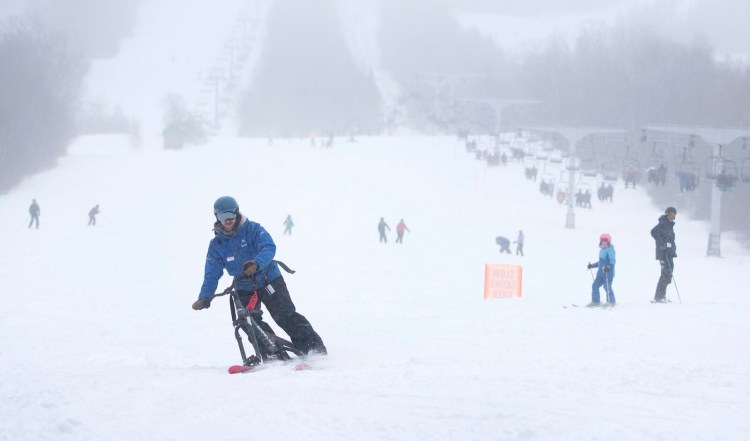CARRABASSETT VALLEY – Skibikes, also called snow bikes, have arrived in Maine — nearly 75 years after the first sit-ski bike was invented. Sugarloaf and Sunday River resorts are renting and selling the bikes this winter, marking the first time the modern skibike has been offered at ski areas here.
Sno-Go Skibikes, the brand that is available in Maine, are more ski than bike: They have no seats, no pedals, and no gears to adjust the speed. The idea is, as with skiing, to let gravity pull the riders over the snow and down the mountain, using the handlebars to guide the bike, and leaning to the inside — or mountain side — to carve into the snow, just as skiers or snowboarders would.
Sugarloaf has offered the bikes for two weeks. As of early last week, about a dozen people had rented them, while at Sunday River (which began offering them Jan. 4) none had. But during a recent afternoon at Sugarloaf, it was clear onlookers were wildly curious.
Skier Sonja DuCharme skied up to a group of three skibikers, including this reporter, who’d stopped at a beginner trail at Sugarloaf. “I saw one for the first time yesterday,” she said. “But this is the first good look I’ve had.”
DuCharme of Kennebunk looked the strange hybrid up and down. She was among dozens of skiers and snowboarders who stopped us during our one-hour ski ride to ask: What is that? Are they hard to ride? Is it difficult to keep from flying off head first? Does it hurt if you crash?

Ski school children check out Sno-Go skibikes at Sugarloaf ski resort. Derek Davis/Staff Photographer Buy this Photo
“Ski bikes are phenomenally stable and easy to learn,” Sugarloaf Ski Instructor Mathias Ringley reassured DuCharme. “It’s a breeze to learn.”
Skibiking basics
The modern snow bike was invented in 1949 by Austrian engineer Engelbert Brenter, whose company Brenter Snowbike still exists. His snow bikes have been used at European resorts ever since. But they were almost never seen in the United States until 1996 when Roger Hollenbeck, the founder of Colorado-based Rocky Mountain Snowbike began importing Brenter Snowbikes.
Sno-Go skibikes weigh around 30 pounds. The handlebars are set on a single front ski, and foot rests with bindings are set on two back skis. The rider stands on the back skis while gripping the handlebars and leaning forward. (Leaning backwards can cause the rider to flip.) A front suspension fork allows some give in the handlebars, which makes the ride less bumpy.
Riders, who wear the same snowsuits and helmets worn by skiers, stop by carving hard into the mountain with their legs and, by extension, their two back skis. Riding straight down the mountain, as with skiing, will cause the ski bike to pick up speed.
Because Sno-Go skibikes are close to the ground, and because snow is generally soft, tumbling off is not necessarily painful. That said, both ski areas require riders to wear helmets with all rentals. Another safety measure is a leash on the bike that is tethered to the rider via a harness. A quick-release device can detach from the harness if the rider falls. Riders must weigh at least 100 pounds to rent the skibikes as the harness may not activate for smaller riders. Renters also are required to take a lesson before they may take the bikes out on their own.
To get up the mountain, riders use the chairlift; Sno-Go skibikes are equipped with a chairlift handle to simplify getting on and off.

Outdoors Reporter Deirdre Fleming carves out a turn while taking a skibike lesson at Sugarloaf ski resort. A lesson is required to rent a skibike, but instructors say learning the sport is easy. Derek Davis/Staff Photographer Buy this Photo
New adventures await
“I describe it as giggle fun,” Sugarloaf snow bike foreman Ben Herman said about the sport, adding that even his own staff is mostly unfamiliar with it. “It’s something you get on and can pick up easily and when you do, you can’t help giggling.
“One of the hard parts of skiing or snowboarding is learning to balance,” he continued. “With ski bikes, it’s stable. You’re splitting your weight between your legs and shoulders, and there are three points of contact. And most everyone has ridden a bike. It’s something that feels comfortable.”
The sport has already attracted at least one famous Mainer. Angus King III took a lesson last weekend with a small group that included his dad, U.S. Sen. Angus King. The younger King said he found skibiking easier to learn at age 49 than snowboarding had been at 30. His lesson, like ours, attracted plenty of onlookers.
“We got a pile of enthusiastic questions along the way. Young people asked where they could get one, older folks asked where the brake was. By the end, we could explain or demonstrate most of the answers ourselves,” King III said.
“It was definitely a fun way to spend a morning,” he continued, “and finding a new way to slide down a hill is always a great adventure to try.”
Comments are not available on this story.
Send questions/comments to the editors.



